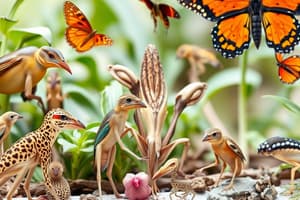Podcast
Questions and Answers
What is the primary function of the PlantNet app?
What is the primary function of the PlantNet app?
- To monitor abiotic factors in ecosystems.
- To instantly recognize and learn about plants. (correct)
- To analyze soil texture for agricultural purposes.
- To identify and understand various animal species.
Which of the following best describes an abiotic factor?
Which of the following best describes an abiotic factor?
- Interactions between different species.
- Living components of an ecosystem.
- Physical non-living elements that affect organisms. (correct)
- The role of a species in an ecosystem.
Which factor is crucial for photosynthesis in plants?
Which factor is crucial for photosynthesis in plants?
- Light intensity. (correct)
- Temperature.
- Dissolved oxygen.
- Soil texture.
How does temperature influence organisms in an ecosystem?
How does temperature influence organisms in an ecosystem?
What does turbidity measure in a water body?
What does turbidity measure in a water body?
Which application is partnered with the National Geographic Society?
Which application is partnered with the National Geographic Society?
What encompasses the ecological niche of a species?
What encompasses the ecological niche of a species?
What type of factors can influence the distribution of a population?
What type of factors can influence the distribution of a population?
What is the biological species concept based on?
What is the biological species concept based on?
What is the significance of a binomial name?
What is the significance of a binomial name?
Which of the following best describes a community in ecological terms?
Which of the following best describes a community in ecological terms?
Which of the following is NOT a defining characteristic of a population?
Which of the following is NOT a defining characteristic of a population?
What element is a major component of an ecosystem?
What element is a major component of an ecosystem?
What does a habitat describe?
What does a habitat describe?
What is an example of a symbiotic relationship as described in the content?
What is an example of a symbiotic relationship as described in the content?
Which statement about ligers is accurate?
Which statement about ligers is accurate?
Which activity allows students to explore ecology by creating a self-contained environment?
Which activity allows students to explore ecology by creating a self-contained environment?
What was a significant impact of the wolf reintroduction in Yellowstone on the elk population?
What was a significant impact of the wolf reintroduction in Yellowstone on the elk population?
In what year was the wolf population at its highest recorded level post-reintroduction?
In what year was the wolf population at its highest recorded level post-reintroduction?
What factor was identified as causing social regulation within the wolf population?
What factor was identified as causing social regulation within the wolf population?
What is one of the tasks students must perform while creating a bottle terrarium or wormery?
What is one of the tasks students must perform while creating a bottle terrarium or wormery?
How has the elk population in Yellowstone changed over the last 15 years based on the text?
How has the elk population in Yellowstone changed over the last 15 years based on the text?
What is one requirement for summarizing wolf population data from Yellowstone?
What is one requirement for summarizing wolf population data from Yellowstone?
What was one significant consequence of eliminating the wolves in Yellowstone prior to their reintroduction?
What was one significant consequence of eliminating the wolves in Yellowstone prior to their reintroduction?
What does the ecological footprint measure?
What does the ecological footprint measure?
How is carrying capacity theoretically estimated in relation to ecological footprint?
How is carrying capacity theoretically estimated in relation to ecological footprint?
Which of the following is NOT a component of ecosystem sustainability?
Which of the following is NOT a component of ecosystem sustainability?
What is a significant role of the Amazon rainforest in its ecosystem?
What is a significant role of the Amazon rainforest in its ecosystem?
What effect does deforestation have on the Amazon rainforest ecosystem?
What effect does deforestation have on the Amazon rainforest ecosystem?
What could result from the Amazon rainforest reaching a tipping point due to deforestation?
What could result from the Amazon rainforest reaching a tipping point due to deforestation?
Which of the following best describes the purpose of nutrient cycling in ecosystems?
Which of the following best describes the purpose of nutrient cycling in ecosystems?
Sustainable ecosystems require a balance between which of the following inputs and outputs?
Sustainable ecosystems require a balance between which of the following inputs and outputs?
What is described by the term 'Carrying Capacity (K)'?
What is described by the term 'Carrying Capacity (K)'?
What occurs during the 'Dieback' phase of a population?
What occurs during the 'Dieback' phase of a population?
Which statement best describes 'Exponential Growth'?
Which statement best describes 'Exponential Growth'?
Which of the following is an example of a density-dependent factor?
Which of the following is an example of a density-dependent factor?
What impact does environmental resistance have on a population's growth?
What impact does environmental resistance have on a population's growth?
What phenomenon is referred to as the 'cascade effect' in ecosystems?
What phenomenon is referred to as the 'cascade effect' in ecosystems?
During which of the following time periods may the wolf population have reached a carrying capacity?
During which of the following time periods may the wolf population have reached a carrying capacity?
What role do keystone species play in an ecosystem?
What role do keystone species play in an ecosystem?
Flashcards are hidden until you start studying
Study Notes
Species Definition
- Organisms that can interbreed and produce fertile offspring
- Estimated 8.7 million species exist
- Only 1.2 million species have been identified (mostly insects)
- Scientific names are used to uniquely identify each species
Classification of Organisms
- Enables efficient identification and prediction of characteristics
- Necessary due to the immense diversity of species
- Two-part binomial name:
- First part: Genus
- Second part: Species
Population
- Group of organisms of the same species living in the same area at the same time
- Capable of interbreeding
- One species may consist of one or many populations
Community
- Collection of interacting populations within an ecosystem
- Example: Coral reef community includes interactions among coral, algae, fish, and invertebrates
Habitat
- Location where a community, species, population, or organism lives
- Described by geographical, physical, and ecosystem characteristics needed for survival
- Example: Clownfish inhabit shallow tropical reefs and live symbiotically in anemones for protection
Ecosystem
- An open system where energy and matter can enter and exit
- Consists of a community and its physical environment
- Example: Forest ecosystem includes biotic components (e.g., trees, animals, fungi) and abiotic components (e.g., sunlight, soil, water)
Ecological Niche
- The role of a species in an ecosystem
- The niche comprises all biotic and abiotic interactions that influence the growth, survival, and reproduction of a population
- Example: How food is obtained
Population Interactions
- Populations within an ecosystem interact with each other in various ways, shaping their population dynamics
Ecological Footprint
- Measures the biologically productive land and water needed to support a population’s consumption and waste
- Carrying capacity is the inverse of the ecological footprint, indicating how many people can be supported based on current consumption
Sustainability in Ecosystems
- Healthy ecosystems maintain a balance between inputs and outputs
- Closed Loop Function: Closed loop ecosystem, where inputs are balanced by outputs
- Long-Lived Ecosystems: Examples like tropical rainforests demonstrate ecosystems that have thrived for millions of years
- Inputs: Solar radiation, organic matter, inorganic nutrients
- Processes: Photosynthesis, energy transfer through food chains, nutrient cycling
- Outputs: Heat, dead organic matter, gases released back into the atmosphere
Tipping Points in Ecosystems
- Human activity can lead to tipping points in ecosystem stability
- Amazon rainforest releases vast amounts of water vapor, contributing to regional rainfall patterns
- Deforestation disrupts transpiration, reducing the release of water vapor
- Deforestation leads to reduced rainfall, creating drier conditions that make the forest more prone to fires
- Continued deforestation could push the Amazon past a tipping point, transitioning it to a drier, savanna-like ecosystem
Wolf Population Dynamics in Yellowstone
- Wolves were reintroduced in 1995
- Wolf population experienced exponential growth initially
- Wolf population reached a carrying capacity around 2004
- Wolf population then exhibited overshoot and dieback in 2008
- Environmental resistance is a limiting factor, impacting wolf population growth
- Carrying capacity of wolves in Yellowstone is estimated between 100 and 200 individuals
Keystone Species
- Keystone species are crucial for the entire structure of their ecosystem
- Keystone species have a powerful influence on the community even if they are not the most abundant
- Keystone predators like wolves keep prey populations in check, preventing overexploitation of resources
- Species like beavers create habitats that benefit other organisms, altering the ecosystem
Studying That Suits You
Use AI to generate personalized quizzes and flashcards to suit your learning preferences.




